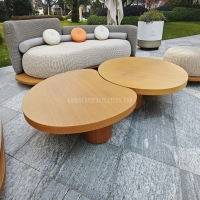Welcome to the website for landscape facilities products and knowledge.
How does the table’s design accommodate the placement of tabletop aquariums or terrariums?
The integration of tabletop aquariums and terrariums into living spaces requires specialized table designs that address unique structural demands. Modern furniture engineering incorporates several critical considerations to safely accommodate these miniature ecosystems.
Primary among these is weight distribution analysis. Quality tables feature reinforced leg systems that transfer weight directly to the floor, preventing stress concentration. Cross-braced frameworks create triangular support structures that significantly enhance load-bearing capacity. The table's center of gravity is strategically calculated to maintain stability when supporting water-filled containers or rocky terrarium landscapes.
Material selection proves crucial in this context. Industrial-grade hardwoods like oak and maple provide exceptional compressive strength, while powder-coated steel frames offer superior weight-to-strength ratios. Water-resistant finishes including marine-grade varnishes and epoxy coatings protect against moisture damage from accidental spills or humidity fluctuations.
Surface engineering addresses both functionality and safety. Tables designed for aquatic or reptile habitats typically feature non-porous surfaces that resist water penetration and are easy to clean. Many incorporate slight perimeter lips or recessed centers to contain minor water spills. Advanced designs even integrate hidden cable management systems for aquarium filters and terrarium heating elements.
The structural integrity extends to vibration dampening characteristics. Tables intended for aquarium use often include rubberized padding between joints and components to absorb vibrations that could stress aquarium seals over time. This attention to minute details ensures long-term viability for housing delicate ecosystems.
Manufacturers have developed specialized tables with integrated support systems that eliminate the need for additional stands. These may feature tempered glass panels with precisely calculated thickness-to-span ratios, or composite materials that combine structural strength with lightweight properties. The evolution of table design continues to focus on creating stable, secure foundations for both aquatic and terrestrial habitat displays, blending aesthetic appeal with engineering precision for today's interior design needs.
Related search:

Recommendation
Elliptical metal outdoor table with nested design, resembling wood grain, round table